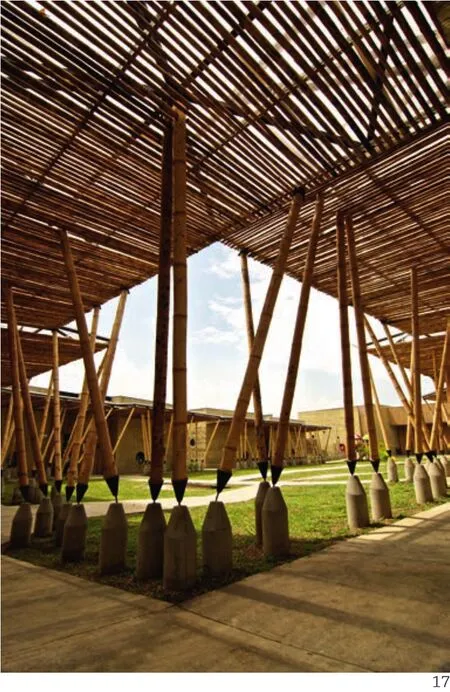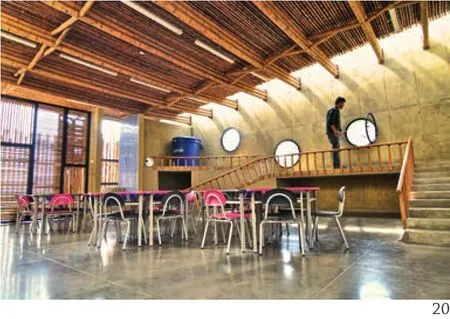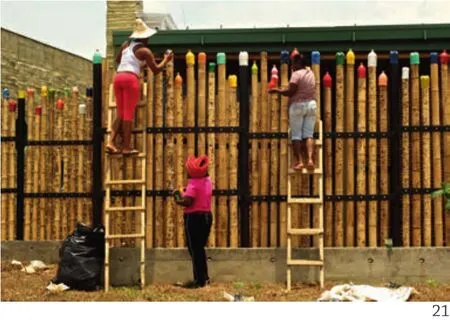瓜达尔儿童中心,考卡,哥伦比亚
建筑设计:丹尼尔·费尔德曼,伊凡·达里奥·基尼奥内斯

1 外景/Exterior view
瓜达尔是一项长达3年的参与式设计和施工的结果。项目在费尔德曼、基尼奥内斯与总统顾问早教办公室的带领下,由多学科专业人员的团队实施。他们的目标是为饱受战争摧残的里卡镇的孩子们设计建造一座幼儿成长和公共聚会的新中心。在中心所需的标准空间 (教室、咖啡厅、艺术室、游乐场、办公室)之外,它还有一个向公众开放的文化设施:虽建在中心里,却是对外的。这样瓜达尔提供了一座公共户外电影院、人行道和剧院广场。这一切使这个地方成为一个公共文化集会的中心。
从内在来说,这个项目也是因地制宜的,因为它使用了本地材料和工人来创造针对特定场地的结果。这个中心不需要机械通风和照明,能收集雨水,使其做到环境友好。从教育上看,建筑是帮助幼儿成长的一种教学手段,它请学生去决定中心的行走路线和使用方式。所有空间都有多个入口,每个房间、露台和卫生间都是内部连通的。这样孩子们就不得不决定他们要去哪儿和怎么去,从而打破了学校让教师主导的固定结构模式,让孩子们成为做决定的人。□(尚晋 译)
El Guadual is the result of a 3-year-long participatory design and construction process lead by Daniel Feldman, Ivan Quinones and the Presidential Advisor for Early Childhood Office along with a team of multidisciplinary professionals who sought to design and build a centre that would offer kids in the war-torn municipality of Villa Rica a new centre for early childhood development and also communal gathering. Besides the standard spaces that the Centre requires (classrooms, cafeteria, art room, playgrounds, offices) it also manages to offer open space to the public. In that way El Guadual offers a public outdoor movie theatre, a catwalk and a theatre plaza, all of which become the place of a cultural communal gathering centre.
Internally the project is also site-specific as it uses local materials and workers to create a sitespecific project. The centre doesn't need mechanical ventilation or lighting and collects rain water making it environmentally friendly. Educationally,the architecture works as a pedagogical tool for children's development by inviting students to decide how to navigate and utilise the centre.Offering multiple entrances to all spaces, internal connections between rooms, and patios &bathrooms in each room, kids are forced to decide how and where they want to break the mold of school as a fixed structure where teachers dominate without allowing kids to be the ones they want.□

2 外廊/Side corridor
项目信息/Credits and Data
地点/Location: 比亚里卡,里卡镇,考卡,哥伦比亚/Villarrica, Villa Rica, Cauca department, Colombia
客户/Client: 哥伦比亚家庭福祉研究所/Instituto Colombiano de Bienestar Familiar, ICBF.
主持建筑师/Principal Architects: Daniel Feldman
总顾问/Presidential Counselor: María Cristina Trujillo de Muñoz
设计团队/Design Team: Plan Padrino, Alta Consejería Presidencial para La Primera Infancia, Presidencia de la república de Colombia, Sandra Pineda, Gabriel Cano, Andrés Ortega, Eugenio Ortiz
制造商/Manufacturers: Guadua macana, Calypso,Metalinox, Lfalum, Reforplas, Acesco, Corona, Argos,Servimontajesy Suministros, Fiberglass Colombia
承建方/Constructor: Fundación Compartir
面积/Area: 1823.0m2
摄影/Photos: Ivan Dario Quiñones Sanchez

3 外景/Exterior view

4 主立面/Main facade

5 A-A剖面/Section A-A

6 B-B剖面/Section B-B

7 C-C剖面/Section C-C

8 侧立面/Side facades

9 侧立面/Side facades
WA:建筑师和城市专家在项目中的作用是什么?
丹尼尔·费尔德曼(简称DF):建筑师的作用是去理解所涉及的多个利益相关方的需求,通过满足那些需求的干预设计追求更大的利益。
WA:最具创意和吸引力的解决方案是什么?
DF:创意和吸引力(与大多数其他衡量建筑的指标)是主观的。找到绝对的答案是不可能的。不过,我的确相信建筑师应该能看出在哪里能给大多数人带来积极的影响,而这在一定意义上是最具创意和吸引力的解决方案。
WA:这个过程中最困难的部分是什么?
DF:在追求社区参与的项目中,社区的实际参与是最大的挑战——尤其是社区很脆弱,在没有明确结果的开放过程中,无法专门为此投入时间。
WA:社区和人们的反馈是怎样的?
DF:一切都取决于结果。从我的情况看,反馈一般都是积极的,因为项目改变了公共建筑在这个地方形成的方式,而社区的作用得到了加强。
WA:这个项目是如何提高人们的生活质量的?
DF:它提高了生活的质量,因为它提供了一个前所未有的教育机构。它还创造了这个地方过去没有的文化活动与集会的空间。最后,它成为了一个让人们相见、加强社区关系的城市新节点。□(尚晋 译)

10 标准教室平面/Floor plan of typical classroom

11 标准教室剖面/Section of typical classroom

12 首层平面/Ground floor plan
WA: What is the role of the architects and urban experts in the projects?
Daniel Feldman (DF): The role of architects is to understand the needs of the multiple stakeholders involved and advocate for the greater good through the design of an intervention that caters to those needs.
WA: What is the most creative and attractive solution?
DF: Creativity and attractiveness (as most other measuring qualities in architecture) is subjective.Finding absolute answers is impossible. However, I do believe architects should be able to understand where positive impact can be achieved for the majority as the most creative and advocate for that solution.
WA: What was the most difficult part in the process?
DF: In projects where community participation is sought, the actual participation of the communities is the biggest challenge. Especially if communities are vulnerable and don't have the privilege of investing time in open-ended processes where results are not definite.
WA: What is the feedback from the people and the community?
DF: All depends on the results. In my case feedback has been generally positive as the projects change the paradigm of how public buildings are developed on the place, and the role of communities is strengthened.
WA: How does this project improve the quality of the people's lives?
DF: It improves the quality of life as it offers an educational institution which didn't exist before. It also created spaces for cultural events and gatherings which the place doesn't have, and finally it became a new urban node where people meet, and community relations are strengthened. □

13 标准教室细部详图/Detail drawing of typical classroom

15 二层平面/Floor 1 plan

14 标准教室剖面/Section of typical classroom
评论
石克辉:战火蹂躏下的儿童心灵极其脆弱。埃尔瓜杜阿尔儿童中心为饱受摧残的里卡镇的幼儿提供了一个战后恢复和健康成长的中心,孩子们自主选择的流线设计和建筑使用方式,使孩子们成为了建筑真正的主人,也使建筑成为了一种教育手段,孩子们的自主、自信在这座建筑里得以建立和加强。
儿童中心同时也为里卡镇的居民恢复正常的社交提供了一个公共聚会的场所。它的布局契合了当地建筑的特点,其在地性引起了当地居民的强烈共鸣,四通八达的平面布置让居民与儿童在建筑内外自由地穿行;因地制宜的取材和当地的建造方式让建筑做到了“环境友好”。
关飞:细读施工图纸你会发现,这不是一组如看起来那样“低技术建造”的房子,埃尔瓜杜阿尔儿童中心采用的是钢筋混凝土墙和钢桁架屋面的结构形式。建筑师尝试将苇席作为模板内衬材料,掺以赭石涂料让钢筋混凝土墙体呈现出一种“夯土墙”的表面质感,隐藏在竹梁上部的是深色钢桁架,聚碳酸酯天窗将自然光线引入到室内,水泥自流平抛光地面下部采用了复合填充的保温材料;镀锌铁板的构造节点做为混凝土墙的压顶防止了雨水对墙体的侵蚀。对于新旧技术的表达,建筑师显然是非常智慧的:所有的技术努力都是在让新技术消失,从而在视觉上让使用者仿佛回归到了埃尔瓜杜阿尔部落式的聚居场景里。在这里,“低技术建造”的表象后面是一种浓厚的人文关怀。
最有意思的还有那些墙上的圆洞,儿童可以混凝土墙间穿行、窥探,厚重的混凝土墙被建筑师赋予了浓浓的“童趣”。

16 外景/Exterior views

17 外景/Exterior views

18 主立面/Main facade
Comments
SHI Kehui: Children's heart is extremely fragile due to the torture of war. El Guadual Children Centre provides a post-war recovery and healthy growing centre for children of Villa Rica who endured the war. Children are able to make their own choices on the flow line design and utilisation modes of the construction. As a result,the children become real owners of the construction and at the same time, the construction becomes an education means, in which children's independency and self-confidence are established and further enhanced.
The children centre also provides a public gathering space for the residents in Villa Rica to regain their normal social life. Its layout matches with the characteristics of local construction and its locality arouses strong resonance among local residents. The all-directionthrough layout makes it easy for the residents and children to go through the barrier-free building, and the application of local materials and construction methods are realised by an "environment-friendly" construction.
GUAN Fei: If going through the details of the implementation blueprint, you will find that it is not a group of houses "constructed with low techniques" as in this case. The construction of El Guadual Children Centre applies a structural form composed of reinforced concrete wall and steel truss surface. The architect tries to apply reed mat in interior decoration together with the ochre coating to present a surface texture of loam wall on the reinforced concrete wall. What is hidden in the upper part of the bamboo beams is steel truss structure, with the polycarbonate windows introducing natural light into the interior space, while the lower part of the cement selfleveling polished ground is filled with heat preservation materials, and the structural nodes of the galvanised iron sheets prevent the erosion of rain water to the wall as the coping of the concrete wall. The architect is apparently very wise about the expressions of new and old techniques: all the technical efforts are intended to make the new techniques disappear so as to from vision level bring the users back to the gathering scene in the El Guadual tribes. Here, behind the appearance of "low technique construction", it is rich in humanistic caring.
The most interesting thing lies in the round holes in the wall, through which children can go through the walls and make their exploration. The thick concrete walls are endowed with profound "child fun" by the architect.

19 电影院/Movie theater

20 标准教室内景/Interior view of typical classroom

21 外景/Exterior view

